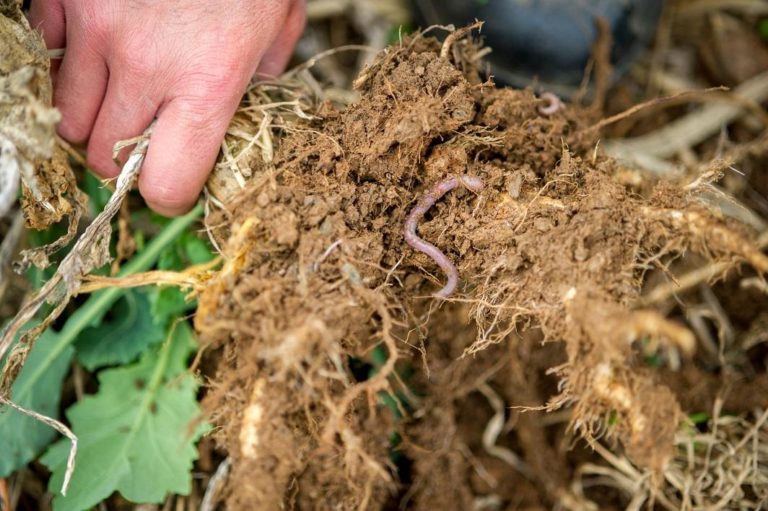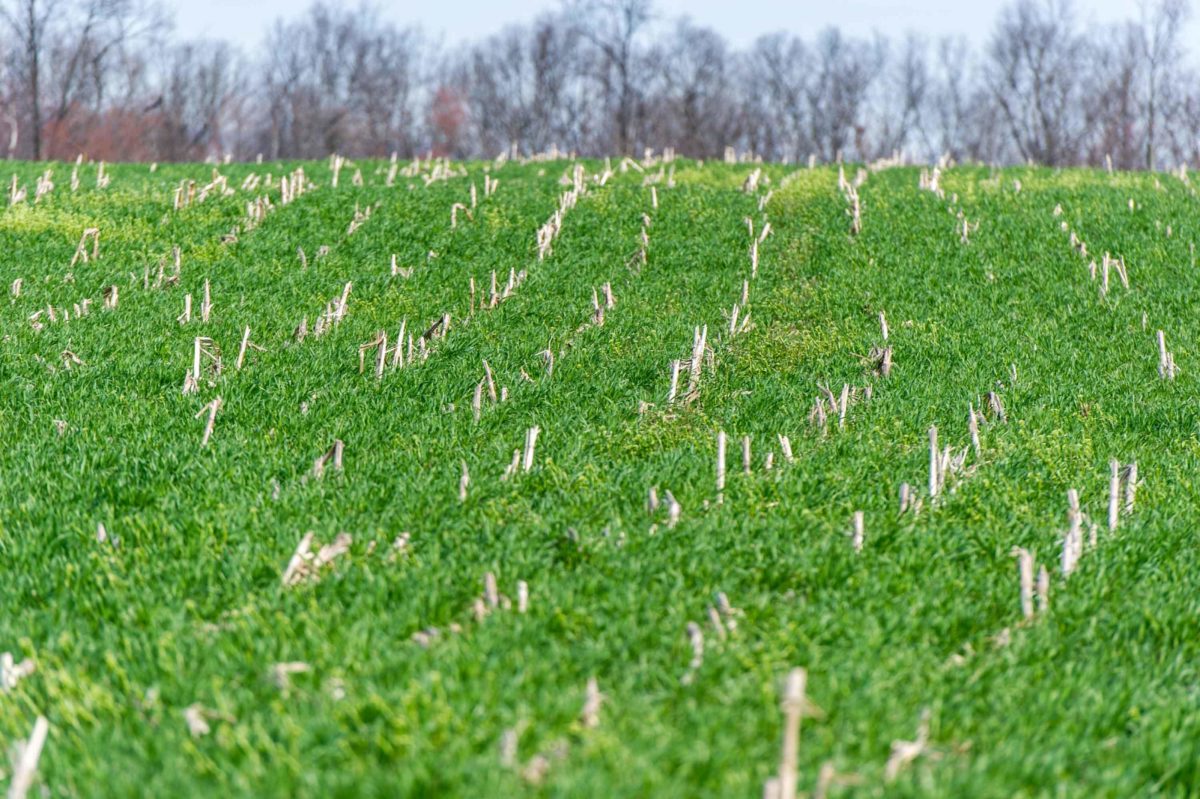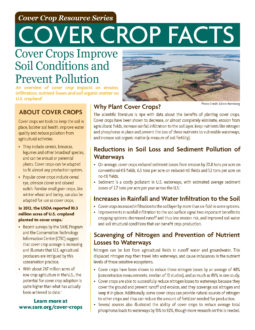An overview of cover crop impacts on U.S. cropland carbon sequestration.

Download this fact sheet (PDF). This fact sheet is part of the Ecosystem Services from Cover Crops fact sheet series.
The Soil as a Carbon Reservoir
Sequestering atmospheric carbon (CO2) in the soil helps to offset greenhouse gas emissions, such as the carbon dioxide emitted by cars, power plants and other burning of fossil fuels. The soil has significant potential to store carbon3 and to mitigate the effects of climate change. Farmers, scientists and policymakers across the globe are particularly interested in the potential contribution of agricultural practices, like cover crops, to the sequestration of carbon in the soil.4
Cover Crop Contributions to Carbon Sequestration
Cover crops are an important soil carbon sequestration strategy. The roots and shoots of cover crops feed bacteria, fungi, earthworms and other soil organisms, which increases soil carbon levels over time. Some farmers think of this sequestration as “restoring” their soil carbon to the level that it was before cultivation or the initial plowing of the soil for agricultural production. Others are calling themselves “carbon farmers” or are expressing the importance of soil health in general by referring to their responsibility to care for the “herds” of microorganisms in the soil.
Though research has addressed the impact of cover crops on carbon sequestration on a global scale, the effect across the United States has not been thoroughly assessed. To address this question, a review and analysis was conducted of five literature sources that included data from 26 separate research trials.5 Each trial was required to have a minimum soil sampling depth of two inches and to have included soil carbon measurements before cover crop management began. For each research trial, a baseline method of analysis was used to understand the carbon sequestration factor associated with cover crop use. Those factors were then aggregated and the low, median and high values obtained. The results of the analysis show that cover crops have the potential to sequester approximately 60 million metric tons of CO2-equivalent per year when planted across 20 million acres (8.1 million hectares), offsetting the emissions from 12.8 million passenger vehicles.6
Achieving a Greater Understanding of What’s Possible
Through this analysis, it became clear that there are some important research needs that must be met to more clearly address the effect of cover crops on soil carbon.
- Sampling at greater depths: The average soil sampling depth referenced in this study was 14.8 inches, but research has shown the need for soil samples to be taken at depths of at least 30 inches to accurately understand the response of soil carbon to management practices.7,8 Otherwise, results may fail to account for 30 percent to 61 percent of the carbon stock that exists deeper into the root zone.9,10
- Pre-treatment measurements needed: Standard practices must be put into place that encourage researchers to take baseline, pre-treatment measurements of soil properties, including soil carbon content. If not, the sequestration potential of various management practices cannot be accurately determined.
Digging Deeper
Planting practices are changing so that cover crops can be grown for longer period of time with increased biomass accumulation. Practices such as interseeding cover crops into standing cash crops or “planting green” (planting a cash crop directly into a living cover crop) can extend the cover crop growing season, allowing for greater root and biomass growth.11 As cover crop acreage increases and more farmers adopt practices that maximize cover crop growth and ground coverage, the potential for biological carbon sequestration will grow.
About Cover Crops

Cover crops are tools to keep the soil in place, bolster soil health, improve water quality and reduce pollution from gricultural activities.
- They include cereals, brassicas, legumes and other broadleaf species, and can be annual or perennial plants. Cover crops can be adapted to fit almost any production system.
- Popular cover crops include cereal rye, crimson clover and oilseed radish. Familiar small grain crops, like winter wheat and barley, can also be adapted for use as cover crops.
1 Myers, R. and C. Watts. 2015. Progress and perspectives with cover crops: interpreting three years of farmer surveys on cover crops. J. Soil Water Conserv. 70(6): 125A–129A.
2 Acreage 06/20/2016. National Agricultural Statistics Service. https://www.usda.gov/nass/PUBS/TODAYRPT/acrg0616.pdf.
3 Batjes, N.H. 1996. Total carbon and nitrogen in the soils of the world. Eur. J. Soil Sci. 47:151–163.
4 Lal, R. 2015. Cover cropping and the “4 per Thousand” proposal. J. Soil Water Conserv. 70(6): 141A.
5 This review was part of a larger assessment of cover crop effects on soil carbon, which assessed the results of 22 different studies and 78 total research trials, and explored cover crop impacts on preventing soil loss and associated emissions.
6 Greenhouse gas equivalencies calculator. Environmental Protection Agency. https://www.epa.gov/energy/greenhouse-gas equivalencies-calculator.
7 Lal, R. 2006. Carbon management in agricultural soils. Mitig. Adapt. Strat. Glob. Change 12: 303–322.
8 Olson, K.R. and M.M. Al-Kaisi. 2015. The importance of soil sampling depth for accurate account of soil organic carbon sequestration, storage, retention and loss. Catena 125: 33–37.
9 Follet, R.F. 2009. US agriculture’s relationship to soil carbon. J. Soil Water Conserv. 64(6): 159A–165A.
10 Jobbágy, E.G. and R.B. Jackson. 2000. The vertical distribution of soil organic carbon and its relation to climate and vegetation. Ecol. Appl. 10(2): 423–436.
11 Report of the 2016–2017 Cover Crop Survey. Joint publication of the Conservation Technology Information Center and the North Central Region Sustainable Agriculture Research and Education Program. Conservation Technology Information Center. https://www.sare.org/Learning-Center/Topic-Rooms/Cover-Crops/Cover-Crop-Surveys.
